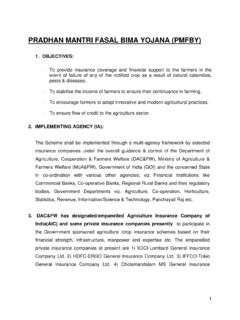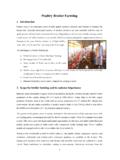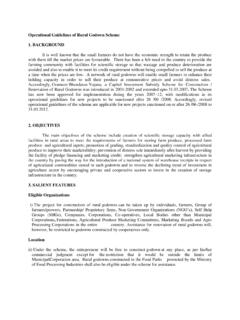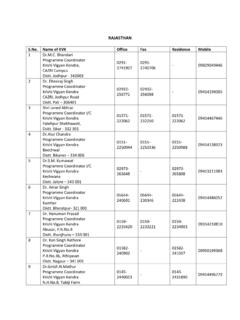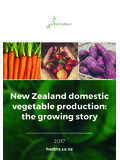Transcription of Low Cost Green Houses for Vegetable Production
1 Low Cost Green Houses for Vegetable Production Agriculture is the backbone of India s economic activity and our experience during the last 50 years has demonstrated the strong correlation between agricultural growth and economic prosperity. The present agricultural scenario is a mix of outstanding achievements and missed opportunities. If India has to emerge as an economic power in the world, our agricultural productivity should equal those countries, which are currently rated as economic power of the world. We need a new and effective technology which can improve continuously the productivity, profitability, sustainability of our major farming systems. One such technology is the Green house technology. Although it is centuries old, it is new to India. Greenhouse Technology Growing plants is both an art and a science. About 95% of plants, either food crops or cash crops are grown in open field.
2 Since time immemorial, man has learnt how to grow plants under natural environmental conditions. In some of the temperate regions where the climatic conditions are extremely adverse and no crops can be grown, man has developed methods of growing some high value crop continuously by providing protection from the excessive cold, which is called as Greenhouse Technology. So, Greenhouse Technology is the technique of providing favourable environment condition to the plants. It is rather used to protect the plants from the adverse climatic conditions such as wind, cold, precepitation, excessive radiation, extreme temperature, insects and diseases. It is also of vital importance to create an ideal micro climate around the plants. This is possible by erecting a greenhouse / glass house , where the environmental conditions are so modified that one can grow any plant in any place at any time by providing suitable environmental conditions with minimum labour.
3 Greenhouses are framed or inflated structures covered with transparent or translucent material large enough to grow crops under partial or fully controlled environmental conditions to get optimum growth and productivity. Advantages of greenhouses : The yield may be 10-12 times higher than that of out door cultivation depending upon the type of greenhouse, type of crop, environmental control facilities. Reliability of crop increases under greenhouse cultivation. Ideally suited for vegetables and flower crops. Year round Production of floricultural crops. Off-season Production of Vegetable and fruit crops. Disease-free and genetically superior transplants can be produced continuously. Efficient utilisation of chemicals, pesticides to control pest and diseases. Water requirement of crops very limited and easy to control. Maintenance of stock plants, cultivating grafted plant-lets and micro propagated plant-lets.
4 Hardening of tissue cultured plants Production of quality produce free of blemishes. Most useful in monitoring and controlling the instability of various ecological system. Modern techniques of Hydroponic (Soil less culture), Aeroponics and Nutrient film techniques are possible only under greenhouse cultivation. GREENHOUSES WORLD SCENARIO There are more than 50 countries now in the world where cultivation of crops is undertaken on a commercial scale under cover. United States of America has a total area of about 4000 ha under greenhouses mostly used for floriculture with a turnover of more than billion US $ per annum and the area under greenhouses is expected to go up considerably, if the cost of transportation of vegetables from neighbouring countries continues to rise. The area under greenhouses in Spain has been estimated to be around 25,000 ha and Italy 18,500 ha used mostly for growing Vegetable crops like watermelon, capsicum, strawberries, beans, cucumbers and tomatoes.
5 In Spain simple tunnel type greenhouses are generally used without any elaborate environmental control equipments mostly using UV stabilised polyethylene film as cladding material. In Canada the greenhouse industry caters both to the flower and off-season Vegetable markets. The main Vegetable crops grown in Canadian greenhouses are tomato, cucumbers and capsicum. Hydroponically grown greenhouse vegetables in Canada find greater preference with the consumers and could be priced as much as twice the regular greenhouse produce. The Netherlands is the traditional exporter of greenhouse grown flowers and vegetables all over the world. With about 89,600 ha under cover, the Dutch greenhouse industry is probably the most advanced in the world. Dutch greenhouse industry however relies heavily on glass framed greenhouses, in order to cope up with very cloudy conditions prevalent all the year round.
6 A very strong research and development component has kept the Dutch industry in the forefront. The development of greenhouses in Gulf countries is primarily due to the extremity in the prevailing climatic conditions. Israel is the largest exporter of cut flowers and has wide range of crops under greenhouses (15,000 ha) and Turkey has an area of 10,000 ha under cover for cultivation of cut flowers and vegetables. In Saudi Arabia cucumbers and tomatoes are the most important crops contributing more than 94% of the total Production . The most common cooling method employed in these areas is evaporative cooling. Egypt has about 1000 ha greenhouses consisting mainly of plastic covered tunnel type structures. Arrangements for natural ventilation are made for regulation of temperature and humidity conditions. The main crops grown in these greenhouses are tomatoes, cucumbers, peppers, melons and nursery plant material.
7 In Asia, China and Japan are the largest users of greenhouses. The development of greenhouse technology in China has been faster than in any other country in the world. With a modest beginning in late seventies, the area under greenhouses in China has increased to 48,000 ha in recent years. Out of this 11,000 ha is under fruits like grapes, cherry, japanese persimon, fig, loquot, lemon and mango. The majority of greenhouses use local materials for the frame and flexible plastic films for glazing. Most of the greenhouses in China are reported to be unheated and use straw mats to improve the heat retention characteristics. Japan has more than 40,000 ha under greenhouse cultivation of which nearly 7500 ha is devoted to only fruit orchards. Greenhouses in Japan are used to grow wide range of vegetables and flowers with a considerable share of Vegetable demand being met from greenhouse Production .
8 Even a country like South Korea has more than 21,000 ha under greenhouses for Production of flowers and fruits. Thus, greenhouses permit crop Production in areas where winters are severe and extremely cold as in Canada and USSR, and also permit Production even in areas where summers are extremely intolerable as in Israel, UAE, and Kuwait. Greenhouses in Philippines make it possible to grow crops inspite of excessive rains and also in moderate climates of several other countries. Thus, in essence greenhouse cultivation is being practiced and possible in all types of climatic conditions. Status in India While greenhouses have existed for more than one and a half centuries in various parts of the world, in India use of greenhouse technology started only during 1980 s and it was mainly used for research activities. This may be because of our emphasis, so far had been on achieving self-sufficiency in food grain Production .
9 However, in recent years in view of the globalization of international market and tremendous boost and fillip that is being given for export of agricultural produce, there has been a spurt in the demand for greenhouse technology. The National Committee on the use of Plastics in Agriculture (NCPA-1982) has recommended location specific trials of greenhouse technology for adoption in various regions of the country. Greenhouses are being built in the Ladakh region for extending the growing season of vegetables from 3 to 8 months. In the North-East, greenhouses are being constructed essentially as rain shelters to permit off-season Vegetable Production . In the Northern plains, seedlings of vegetables and flowers are being raised in the greenhouses either for capturing the early markets or to improve the quality of the seedlings. Propagation of difficult-to-root tree species has also been found to be very encouraging.
10 Several commercial floriculture ventures are coming up in Maharashtra, Tamil Nadu and Karnataka states to meet the demands of both domestic and export markets. The commercial utilization of greenhouses started from 1988 onwards and now with the introduction of Government s liberalization policies and developmental initiatives, several corporate Houses have entered to set up 100% export oriented units. In just four years, since implementation of the new policies in 1991, 103 projects with foreign investment of more than crores have been approved to be set up in the country at an estimated cost of more than crores around Pune, Bangalore, Hyderabad and Delhi. Thus the area under climatically controlled greenhouses of these projects is estimated to be around 300 ha. Out of which many have already commenced exports and have received very encouraging results in terms of the acceptance of the quality in major markets abroad and the price obtained.


